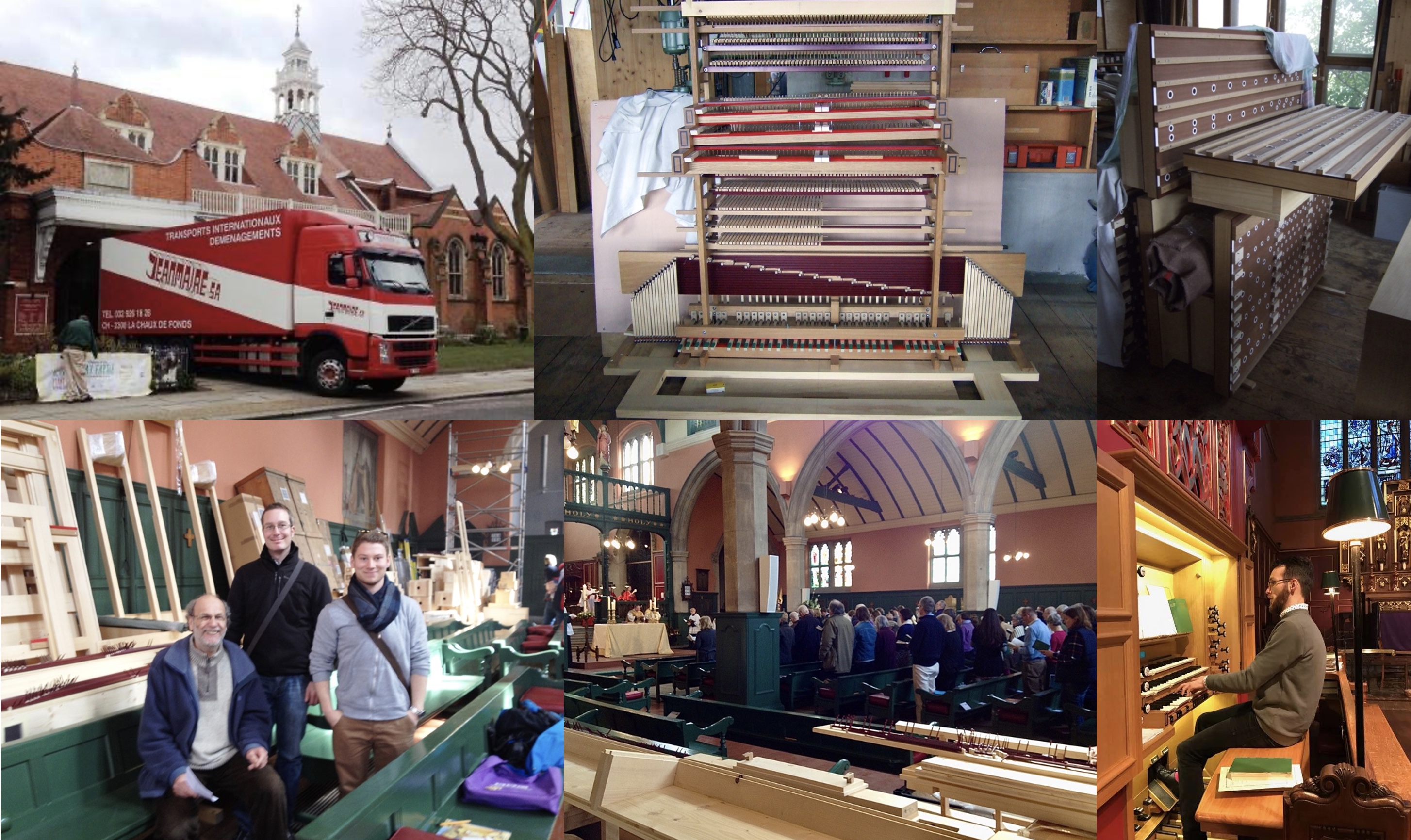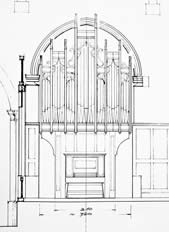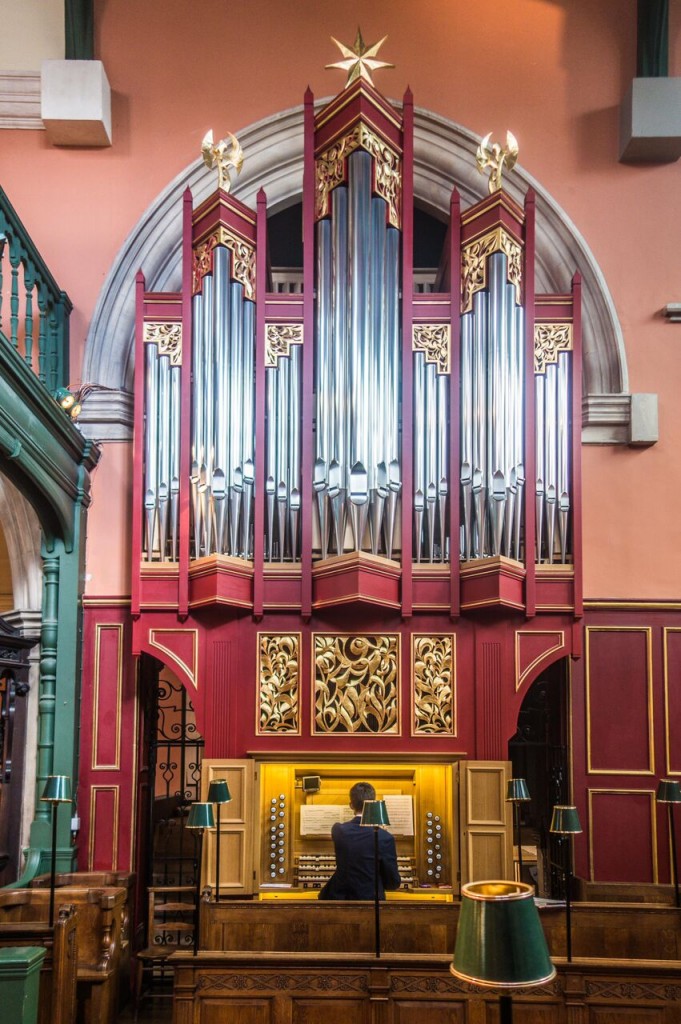
Scroll down for an interview with the organ makers, Alain Aeschlimann and Jacques-André Jeanneret, from the Manufactures d’Orgues St. Martin.
See ‘First Friday’ Lunchtime Organ Concerts.
Jonathan Dods, Director of Music, wrote in 2013:
The most exciting development in the music of the Church in recent years has been the building of our new organ, together with two meeting rooms in the vestry and sacristy. The organ was blessed by the Lord Bishop of London at a special service of Thanksgiving on 26th September 2013 and has been a huge project in terms of the time it took to make detailed plans and carry them out, and to raise the considerable funds.
It might seem to have been a brave decision, given the current climate, even a selfish one with so many people in need. But we are convinced that since something had to be done, it behoved us to do it well, and to create something of value not just for us but for future generations, just as the founders of our Church did for us.
Worship, in which music plays a central role, is at the heart of who we are; it challenges us and guides all our activities. This great project has transformed St Michael’s, its music, its worship and its whole life; it is helping all of our activities to flourish. The fund raising continues to pay off our final loans.
 Four organ builders of international stature visited the Church and made detailed proposals. Our adviser Dr John Rowntree, the PCC and I agreed that one builder stood out for its inspired design and the quality of their instruments: St Martin of Switzerland. Detailed architectural plans were prepared (see detail, left) and were submitted to the Diocese and the Victorian Society.
Four organ builders of international stature visited the Church and made detailed proposals. Our adviser Dr John Rowntree, the PCC and I agreed that one builder stood out for its inspired design and the quality of their instruments: St Martin of Switzerland. Detailed architectural plans were prepared (see detail, left) and were submitted to the Diocese and the Victorian Society.
Work began in July 2012 and our new organ was ready for its first performance in September 2013. After more than six years’ planning and fundraising, it was played formally for the first time at a service of Thanksgiving in the church on September 26th 2013 (photograph below).
The Choral Mass included Langlais’ Messe Solennelle and Tavener’s God Is With Us, with singing led by St Michael & All Angels’ choir. Refreshments afterwards celebrated the completion of the project. The organ was blessed by the Bishop of London, the Rt Revd and Rt Hon Richard Chartres.
“This was a very proud moment for us” said Fr Kevin. “It’s the culmination of six years’ planning and fundraising, to replace our old organ with a magnificent new instrument that will enhance our worship and bring joy to our congregation and to concert audiences for many years to come.
“It’s been a huge effort on the part of many people. The service gave us the chance to say thank you to them and we were delighted that the Lord Bishop of London came to bless the organ and officiate at our Choral Mass of Thanksgiving. It was a wonderful occasion and we were delighted to see so many people there including two members of the organ building team from Switzerland”.

The organ was built in Switzerland by the specialist firm La Manufacture d’Orgues St Martin. It has 1,667 pipes, many of which were sponsored by individuals and groups under the church’s Pipe Up! appeal. Other funds were raised from the Bedford Park Festival. fund-raising Balls and a Hymnathon.

(From the Mass of Thanksgiving and Blessing service sheet in 2013)
Our Grateful thanks to everyone who participated in the success of this project
La Manufacture d’Orgues
St Martin, Neuchatel, CH Alain Aeschlimann, Jacques-André Jeanneret, Cedric Fuchs, Cedric Neuhaus
Organ Consultant John Rowntree
Designer, organ pipe shades and angels Alan Caiger-Smith
Pipe shades, carver Keith German
Organ case painters Howell & Bellion Stephen Bellion
Designers & makers, wrought iron gates Aidan Hart & Frazer Picot
Mitre Construction Company Alan Ranscombe, Mark Smith, Barry Morris
Sawyer & Fisher Quantity Surveyors Graham Broad
Carden & Godfrey Ian Angus, David Graham
Electrician James Scott
Architect & Assistant Organist Oliver West
Architect & Choir member John Scott
Vicar and Chair of PCC Fr Kevin Morris
Director of Music Jonathan Dods
Church Warden Helen Wareham
Church Warden Michael Robinson
Church Warden Nicola Chater
Church Warden, & Chair of Fundraising Jane Trigle
Finance Alan Trigle
Donation of chamber organ Giles & Ruth Ridley
Providers of Accommodation for the Organ Builders:
Laurence & Marjolein van Kampen Brooks, Amanda & Chris Bradley, Sarah & Mark Radcliffe, Philip & Helen Wareham, Torin & Carol Douglas, Louise & Patrick Grattan and Michael Pownall
And thanks to all those who have so generously given donations and raised funds for this project. Also to all the users of St Michael and All Angels for their patience and goodwill during the building works and installation.
From A Short History of our New Pipe Organ (2013), compiled by Jim Cox and David Beresford
The new organ with its 1,667 pipes, comprising twenty-five stops, is spread over three manuals and pedals. It is the culmination of fifty years of the art and craft of organ building in the village of St Martin, above Neuchatel, by Alain Aeschilmann and Jacques-Andre Jeanneret and was designed in consultation with Dr John Rowntree, our organ advisor. The music tonight reveals that the organ has not only met its brief; playing music by French, German and English composers and providing a fitting complement to our worship this evening, with sensitive choral accompaniment and solo adornment of the liturgy, but it is also a very beautiful, musical instrument, something we can be proud to pass on to future generations at St Michael & All Angels.
Introduction by Fr Kevin Morris
Our new church pipe organ is designed primarily to accompany liturgical worship, though it will also be used in concerts and recitals too. It adorns the church building. In both senses therefore the organ had to be beautiful – as a musical companion to the worship of Almighty God, and so to evoke ‘the beauty of holiness,’ and also as an attractive piece of furniture in rapport with the architecture of our church. Our vision for a new organ was for an instrument that could provide the delicate undergirding for plainsong, a colourful accompaniment to choral settings, the clarity and power to rouse a full church into joyful hymnody and a varied palette of sounds conducive to organ voluntaries in the German, French and English repertoires. It was to be an instrument that would also be worthy of the best recitalists. We believe that vision has been fulfilled.
St Michael’s itself is a famous Arts and Crafts building and so it was important to us that superb craftsmanship and materials were used throughout. The organ builders, St Martin, astonished us with the beauty and intricacy of their skills and the quality of the materials with which they worked, as we saw the whole instrument being put together before our eyes. The organ case is decorated with pipe shades, angels and cymbelstern star designed by the renowned potter and writer on pottery, Alan Caiger –Smith, and painted by prestigious church restorers, Howell and Bellion. The gates either side of the organ were designed by Aidan Hart, a sculptor and icon writer and hand forged by master blacksmith Frazer Picot. It is a beautiful instrument to look at and to listen to.
The History of Organs at St Michael & All Angels
When St Michael’s was consecrated by the Bishop of London in 1880 it had no organ. It also had no pulpit, lectern, font or stained glass in the east window and the north aisle, chapel and hall had not been built. Music for worship was provided on a small portable organ hired from Hills. Ten years later, by 1890, much of the above had been added. The pulpit then came in 1894 and the chapel was built in 1909.
It was in 1890 that the first built-in organ was installed. Designed and built by Bryceson (of barrel organ fame) it was eventually to have 26 stops. However. initially costs would only allow ten stops but it was located at chancel level on the south side with space to accommodate pipework for the full 26 stops when there was enough money. This location, at chancel level, was exactly where Norman Shaw had shown an organ on his original drawings – and where the new organ is now located. In 1894 a further nine stops were added and in 1902 six more thus completing the instrument as designed in 1890. The work was carried out by Hunters of Clapham and dedicated by the Bishop of Kensington on December 21st.
In 1925 there was a major change. Barely twenty years from the completion of the organ in the location it was designed for it was completely dismantled and re-erected at a higher level to allow the construction of a chapel, later to become the sacristy, in the space at chancel level. The Bryceson organ in its ‘complete’ form was crammed into a smaller volume at high level with inevitably a loss of sound quality but nevertheless was to serve the church for the next 82 years! There was however, in that period, probably in the 1960’s, yet a further alteration to the original when the action was ‘electrified’ from the original mechanical action though none of the pipework was altered. Over the years in spite of some heroic work by Nottermans who maintained it, the action deteriorated, the bellows rotted and the original Bryceson sound, already severely compromised by the move up in 1925, ceased to be heard.
It was inadequate for the musical aspirations of a flourishing church with fine acoustics and the space for large scale music events. We now have a fine instrument. worthy of the church and its musical community. in the location originally envisaged.
Interview with the organ makers, Alain Aeschlimann and Jacques-André Jeanneret, from the Manufactures d’Orgues St. Martin.
What inspired you to take up organ-making and is it in the family?
Alain: It was through music, and specifically through my piano teacher at school. He played the organ in church and introduced me to it and I was conquered. It is certainly not genetic as there was no family history of organs and though my daughters are interested they have not made it their life’s work as I did.
J-A: I got bitten by the organ bug very early on in childhood. I used to play church with my little brother, my brother as the pastor and me as the organist! I have a grandmother and a great uncle who were organists in the nearby village of La Sagne, so perhaps it was in the blood. And I took over as church organist there at the age of 15, and still play there from time to time. I have daughters who studied at a conservatory of music for a while, playing the flute and the trumpet respectively, but they gave up, to my great regret.
How is organ craft transmitted down the generations? Does not it give you a frisson thinking about the Bachs and Buxtehudes before you?
Alain: Absolutely. Definitely a frisson, and it makes you feel ever so small, so modest. I was lucky to have such passionate and learned mentors, especially Georges Lhôte, to pass on the mysteries of organ making to us when we took over in 1982. Lhôte had learned his tradecraft from the great Gonzalès in France, who had in turn worked under the direct successors of Cavaillé-Coll. So there is a long line of transmission down the generations there.
J-A: I do feel a little emotional about the past, yes, but you have to remember that organs made by the great organ makers of this world are still being played today, and the mediocre ones have long disappeared. I too have Neidhart and Lhôte to thank for passing on their skills and knowhow, as well as the harmonists, Linde and Jemlich. I hope we will be able to pass on what we have learned to the next generation ourselves.
What is it about organs?
Alain: The way it holds the sound, the variety of colours, the softness [sweetness] of some of its timbres [stops], like the grands tutti, all of which allows you to express so many different states of your soul.
J-A: It is not called the King of Instruments for nothing. What we find fascinating is knowing that through our work we give the pleasure of music to so many people and our organs play such a central role in religious services.
Is organ-making something spiritual or just a piece of carpentry?
Alain: Both. When we are making it in the workshop perhaps not but once we hear it being played in church we cannot help being moved spiritually.
J-A: For me the spiritual side is never far away even when I am making it in the workshop, but it of course culminates when I am actually in a church sorting out the harmonics. It’s what makes our job so different from others, that blend of the technical and the sensual.
How many organs have you made?
Alain: We make about one a year.
J-A: And the one we have made for St Michael’s is our 41st since we took over in 1982.
Interview conducted and translated by Philip Wareham